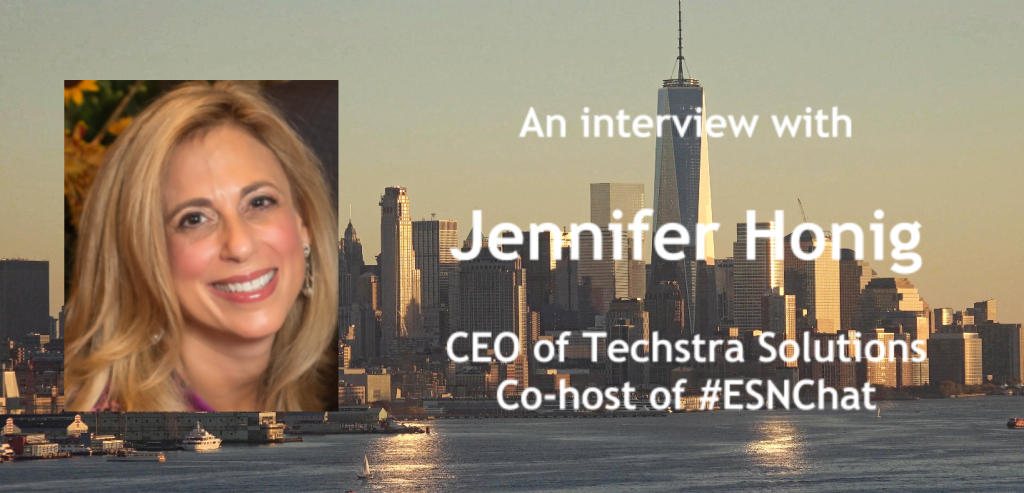The Journey to Digital Transformation
Article by Ari Brown, Techstra Solutions
Jennifer Honig is the Chief Executive Officer of Techstra Solutions, LLC. Jennifer received her MBA from Carnegie Mellon’s Tepper School of Business, and has over 25 years of experience in the areas of marketing and consulting.
How does your experience inform the decisions you make in your role of CEO at Techstra Solutions?
JH: At Techstra Solutions our company has continued to evolve and solidify over time. We focus on digital transformation and the merging of digital strategy, operational impact, technology and talent. Our clients have enthusiastically embraced our holistic, 360-degree approach to business transformation. I know my experience has informed the decisions I have made along the way in order for us to arrive at this point.
I have worked in both large global companies and start-ups. They have enabled me to tackle my role as CEO from two distinct vantage points. In large companies, I learned to manage complexity and navigate the organizational structure to get things done. Socializing and building consensus for change is key.
A startup begins as a dream that turns into a vision, and each person contributes and is connected to its success. In a startup, you must jump into multiple roles, make educated guesses, and rely on your networks to make things happen. They have limited resources initially, and every decision must be a calculated one.
My amazing network of friends and family have helped me along the way. Taking their counsel was critical. But that is not enough. Becoming a successful company requires that I surround myself with a team that is proactive, makes good decisions and understands tradeoffs. A great CEO once said to me, “I like that you challenge me. Ultimately, I know we will arrive at an optimal solution because you were not afraid to question things or take a different perspective. I also know that once the discussion is over, we will be aligned and walk out the door with the same agenda.” The second part of his comment is as important as the first.
I am lucky to have Nancy Gill, Chief Disruption Officer for Techstra Solutions, as a part of the team to help shape our vision and bring it to life. She has years of experience in Human Resources and understands transformation from a leadership and people standpoint. It balances my own experiences. She is just one of many people in our organization that I learn from every day and who ultimately make our clients successful, and us also by default.
You authored a white paper about the opportunities that crowdsourcing can bring to an organization. In what ways do you think crowdsourcing can be effective, and what are some simple steps executives can take initially to get crowdsourcing started?
JH: Crowdsourcing is a very effective way to capture ideas and to solve problems. Great ideas are no longer relegated to an R&D center. Crowdsourcing enables you to tap ideas resident within your organization to realize business value – whether it’s on new products and services, or expansion on services already provided. By leveraging crowdsourcing as a critical component of a company’s DNA, the company taps into the collective resources and knowledgebase of the organization. It provides great ROI.
How do you get started with crowdsourcing?
Getting crowdsourcing started in an organization is a four-step process.
Step 1: It takes a leader who understands crowdsourcing and the opportunity as well as the business value it creates for their organization. They must know that it needs to be an integrated program in the organization and is resourced properly.
Step 2: Have a crowdsourcing tool that enables the functionality of Crowdsourcing. Enterprise Social Network Vendors (Jive, IBM Connections) and niche players (Spigit) have software that facilitates the process of crowdsourcing and the management of the crowdsourcing process.
Step 3: Make it a priority within the corporation – visible at the highest levels – so that people understand that their time spent participating in the program is valuable to the CEO and executives.
Step 4: Implement ideas! Ideas must progress and be implemented after people have spent time investing their energy in their development. The process must be transparent so participants understand how their ideas are evaluated and the thresholds for progression to the next stage.
You’re a co-host of the weekly #ESNchat on twitter, how has interacting with enterprise social networking (ESN) voices all around the world influenced the way you manage your ESNs right now?
JH: I learn something from our ESNchat participants every week. Participants are from all over the world; some are social business leaders, some consultants and some are just interested in ESNs. They each bring a unique perspective to the topic.
We talk about everything from leading edge topics such as virtual reality, chatbots and machine learning to the tactical – communication plans and executive leadership within an ESN. The depth and breadth of the topic is crucial. Companies that look at social business as one-dimensional have a very limited view of the opportunity. Community leaders who understand the complexity of ESNs want to learn from others and are more successful as a result.
Within a single organization, there may be only a few resources. They don’t have access to the type of thought leaders that are found on ESNchat. The chat enables people to talk through best practices and different approaches as well as make connections. My online relationships have expanded well beyond the hour we spend together each week.
(#ESNchat is Thursday at 2 ET on Twitter.)
What should leaders focus on right now?
JH: Digital transformation is not a buzzword; it’s reality. And if you’re going to implement change, you need to focus on all the complexities that come with digital transformation.
As a leader, you have a responsibility for leading the company through this time of transition. You must empower the organization to become more agile in the way they serve customers and in the way they work. Many organizations resist change, and even try to kill it. We focus on preparing teams to continually adapt. In addition, initiatives have to be resourced properly to be successful.
A great example is what’s going on in retail – online shopping is surpassing brick and mortar. People want the instant gratification of finding a product easily, at a great price, and having it delivered quickly. This translates into other industries. Your customers expect to work and deal with you and your products the same way. This changes the pace of business and what is required for you to be competitive. The more the entire organization is able become agile and adaptable, the more successful it will be.
Last, but certainly not least – read, read, and read more – things are changing rapidly and you need to be on top of the latest trends. I spend a lot of time reading on many diverse topics. It is critical to make connections, to see patterns emerging in what you read and apply it to your work.
What is the one skill critical for success in a time of transformation?
JH: In this day and age, communication is king. Effective leaders clearly and effectively communicate in multiple channels: social media, writing, presentations, videos, etc. – internally and externally, and frequently. In a time when transparency is expected, how and what you communicate is vital, not only for your personal brand, but also for that of your company.


Thanks for your blog, nice to read. Do not stop.